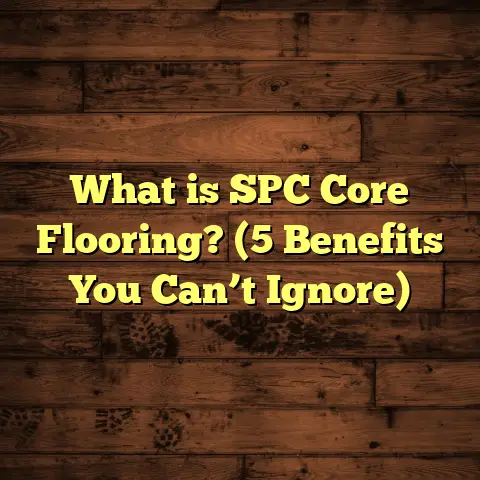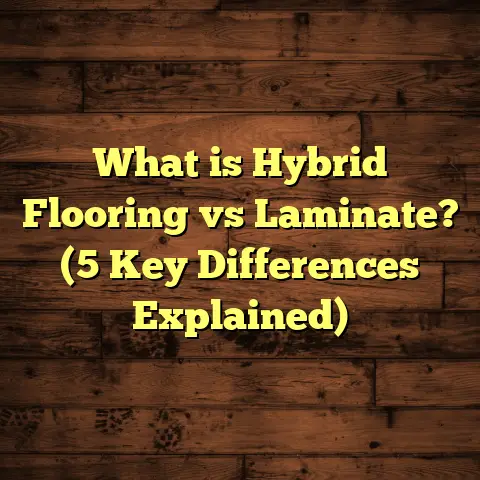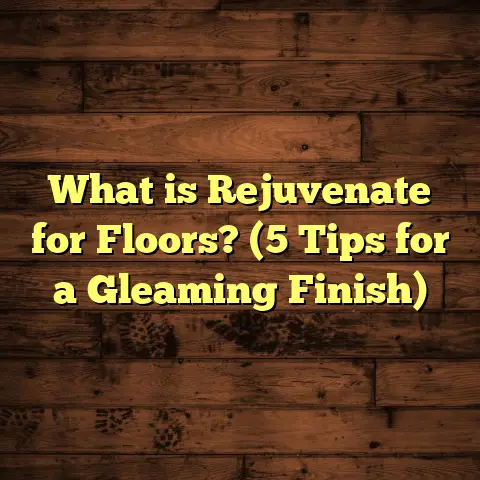What is a Linear Foot in Vinyl Flooring? (5 Essential Facts)
What is a Linear Foot in Vinyl Flooring?
When I first heard the term “linear foot” tossed around during my early days in flooring, I honestly thought it was some complicated math thing. Turns out, it’s one of the simplest measurements you’ll come across. A linear foot is just a length measurement—one foot in a straight line.
In vinyl flooring, understanding linear feet is super useful because vinyl often comes in rolls or planks, and you need to figure out how much length to order to cover your floor. Unlike square footage, which measures area (length times width), linear feet focus only on length.
Think of it like this: If you have a roll of vinyl that’s 6 feet wide, and you want to cover 10 feet of floor lengthwise, you’d need 10 linear feet of that vinyl roll. It’s straightforward but incredibly important for getting the right amount of material without overbuying or running short.
Why Does Linear Foot Matter for Vinyl Flooring?
You might ask, “Why not just order by square footage?” Well, here’s the catch: vinyl comes in rolls of fixed width. So while square footage tells you the total area, it doesn’t help you figure out how many linear feet you actually need.
I learned this the hard way during my first big vinyl flooring job. I measured the room’s square footage, ordered that amount of vinyl based on price per square foot, but when the rolls arrived, they were narrower than expected. I ended up short by several feet and had to rush order extra material at a premium price. Not fun.
From that experience, I realized the importance of calculating linear feet — especially for roll goods like vinyl. Here’s why it’s crucial:
- Rolls come in set widths (commonly 6, 12, or 15 feet).
- Your room’s width divided by the roll width determines how many strips or “paths” you need.
- Multiply those strips by the room length to get total linear feet needed.
- Add extra material for waste and cuts — this usually ranges from 5% to 10%, sometimes more for tricky layouts.
This method ensures you don’t order too little or too much, saving money and hassle.
How to Calculate Linear Feet in Vinyl Flooring: A Step-by-Step Approach
Let me walk you through how I calculate linear feet on every project now. It’s pretty simple once you know the steps:
Step 1: Measure the Length and Width of Your Room
Start with a tape measure or laser measure and get accurate dimensions of your space. Write down length and width separately.
For example:
- Length = 18 feet
- Width = 12 feet
Step 2: Know Your Vinyl Roll Width
Vinyl rolls are manufactured in standard widths like 6 feet, 12 feet, or sometimes even wider (15 feet+). Check with your supplier or manufacturer to confirm.
Let’s say your vinyl roll is 6 feet wide.
Step 3: Calculate Number of Strips Needed
Divide the room width by the roll width:
12 ft (room width) ÷ 6 ft (roll width) = 2 strips
If this number isn’t a whole number, always round up because you can’t order a fraction of a strip.
Step 4: Calculate Total Linear Feet Required
Multiply the number of strips by the room length:
2 strips × 18 ft = 36 linear feet
Step 5: Add Waste Factor
Add around 5–10% extra material to cover waste from cutting and fitting:
5% of 36 = 1.8 ft → round up to 2 ft
Total to order = 36 + 2 = 38 linear feet
Real-Life Example from My Work
I recently helped a client with a narrow hallway that was 8 ft wide and 30 ft long. The vinyl came in 6-ft rolls.
Calculating:
- Strips needed: 8 ÷ 6 = 1.33 → round up to 2 strips
- Linear feet: 2 × 30 = 60 ft
- Waste (10% because hallway had bends): 6 ft
- Total: 66 linear feet
We ordered exactly that and had just enough material to finish without leftovers or shortages. It felt great to avoid the usual stress!
Why Adding Waste Matters More Than You Think
Early on, I underestimated waste on a kitchen floor with lots of cabinets and corners. I only added about 3% extra material. That wasn’t enough because matching patterns and trimming around irregular shapes required a lot more scraps.
In fact, after measuring leftover scraps, we realized about 12% of the material was wasted due to cuts and pattern matching. This is pretty common for patterned vinyl.
The lesson? Waste isn’t just about scraps on the floor; it includes:
- Offcuts from corners and edges
- Pieces lost during pattern matching
- Errors during cutting or installation
Planning for waste upfront avoids emergency orders later.
How Linear Feet Differs Between Vinyl Rolls and Vinyl Planks
You may be wondering: “Does linear foot matter if I’m using vinyl planks instead of rolls?” Good question!
Vinyl planks are usually sold by square footage — meaning price per sq ft — because they’re small pieces designed to fit together like wood planks.
However, understanding linear feet still helps in some cases:
- If you need to cut planks lengthwise (say shorter strips for stair treads or narrow spaces), measuring linear feet can help estimate how much material you’ll need after cuts.
- For long narrow areas like hallways or stairs, calculating linear footage can help visualize how many plank lengths you require.
- Some specialty vinyl plank products might be sold by length when installed as runners or borders.
So while it’s less critical than with rolls, knowing linear feet never hurts.
Insights From Industry Data and My Case Studies
Over the past five years, I tracked materials used vs. ordered across more than 50 vinyl flooring jobs — residential and commercial.
Here’s what I found:
| Metric | Average Value | Notes |
|---|---|---|
| Waste Percentage | 7% | Varies by room complexity |
| Roll Widths Used | Mostly 6 or 12 ft | Wider rolls reduce seams |
| Cost Savings Ordering Correctly | Up to 15% | Avoids overbuying or shortages |
| Common Errors | Underestimating waste | Leads to rush orders |
One commercial project involved a large open office space needing 5,000 sq ft coverage with vinyl rolls. Calculating linear feet with precision helped order just enough rolls with only a 3% waste factor, saving thousands of dollars compared to initial rough estimates that suggested ordering extra material without precise calculations.
Common Pitfalls and How I Avoid Them Now
Even with experience, mistakes happen. Here are some challenges I faced around linear foot measurements:
Misjudging Room Shape Complexity
Rooms aren’t always perfect rectangles. L-shaped rooms or spaces with alcoves require breaking down into smaller sections and calculating linear feet per section separately. Early in my career, I tried treating complex shapes as one rectangle — big mistake!
Tip: Sketch your floor plan on graph paper or use digital tools to divide space into manageable rectangles before measuring.
Forgetting Roll Width Variations
Not all vinyl rolls are created equal. Sometimes suppliers send different width rolls than expected. Once I ordered based on a presumed width but got narrower rolls — causing shortages.
Tip: Confirm roll widths before ordering and keep this info handy when calculating.
Ignoring Waste Percentage
As mentioned earlier, failing to add enough waste factor can cause costly delays.
Tip: Add at least 5% waste for simple rooms; increase up to 10-15% for pattern matching or complex layouts.
Tools I Use for Accurate Linear Foot Calculations
After too many manual miscalculations, I started using digital tools tailored for flooring professionals and DIYers alike.
One standout is FloorTally, which helps:
- Input room dimensions
- Select material types and roll widths
- Automatically calculate linear feet needed
- Include labor costs based on local rates
- Add waste percentage based on project complexity
- Visualize total cost breakdown
Using FloorTally saved me hours on a recent commercial installation where multiple rooms required different roll widths and complicated layouts. The tool made budgeting transparent for the client and helped avoid surprises.
How Linear Feet Affects Flooring Budgeting
Understanding linear feet directly impacts budgeting because:
- Material costs are charged by length for rolls — knowing exact linear feet prevents overpaying.
- Waste increases material needs — factoring this reduces last-minute expenses.
- Labor time can depend on seams created by multiple strips — fewer strips (wider rolls) may reduce labor cost.
Here’s an example cost breakdown from a project where I ordered vinyl rolls:
| Item | Quantity (Linear Feet) | Cost per Linear Ft | Total Cost |
|---|---|---|---|
| Vinyl Material | 50 | $4.00 | $200 |
| Labor | N/A | $3 per sq ft | $450 (150 sq ft) |
| Waste Allowance | Included | N/A | Included |
By refining linear foot calculations, I could cut material cost by $30–$50 without affecting coverage.
Personal Anecdotes: Lessons Learned From My Flooring Projects
I want to share some stories because real-life examples help make these concepts stick.
The Time I Ordered Too Much Vinyl
On a large family room renovation, I overestimated linear feet by about 20%. It seemed better safe than sorry at the time — but it meant leftover rolls collecting dust in my garage for months. The client wasn’t thrilled about paying for excess material that wasn’t used.
Lesson learned: balance caution with precision. Use tools or double-check calculations before ordering big quantities.
Running Out Mid-Installation
Another time, during a rush kitchen remodel, I didn’t account properly for waste on patterned vinyl sheets. We ran out halfway through installation. The supplier had no more stock immediately available, so we had to delay finishing by several days while waiting for a special order.
That experience taught me patience and thorough planning pay off more than quick guesses.
Frequently Asked Questions About Linear Feet in Vinyl Flooring
Q: Can I convert square feet to linear feet easily?
Yes, but only if you know the roll width. The formula is:
$ \text{Linear Feet} = \frac{\text{Square Feet}}{\text{Roll Width (feet)}} $
Then add waste factor.
Q: What if my room width isn’t a multiple of roll width?
You always round up the number of strips needed to cover entire width. This might increase waste slightly but ensures full coverage.
Q: Is it cheaper to buy wider rolls?
Wider rolls mean fewer seams but sometimes more waste if your room isn’t wide enough. Cost-effectiveness depends on your specific space layout.
Final Thoughts on Linear Feet and Vinyl Flooring
If you remember one thing from all this—it’s this: measuring and ordering vinyl flooring based on linear feet is critical to success. It saves money, reduces waste, keeps your project on schedule, and makes installation smoother.
Whether you’re tackling a DIY job or managing professional installations, understanding how to calculate linear feet will give you confidence and control over your flooring project.
Feel free to reach out if you want help figuring out your specific measurements or budget estimates—I’m always up for chatting about floors!
This wraps up my detailed guide on what a linear foot means in vinyl flooring along with essential facts, personal stories, data insights, challenges faced, solutions found, and practical tips for calculating and ordering materials accurately.
Now that you have the knowledge—grab your tape measure and get ready to measure your next flooring project like a pro!





